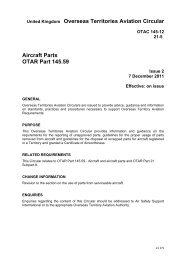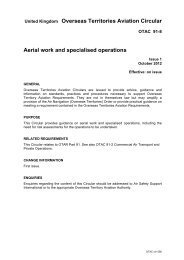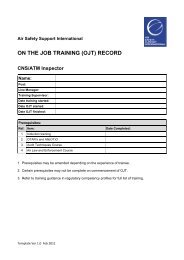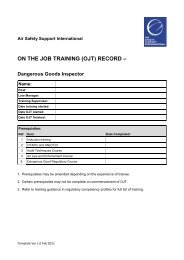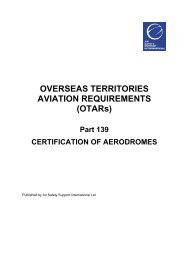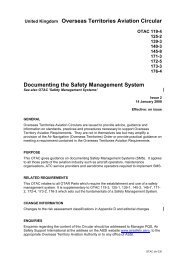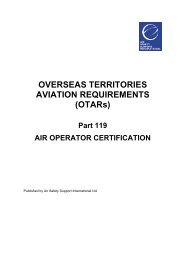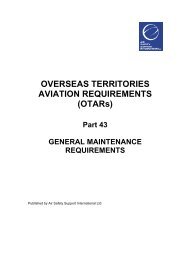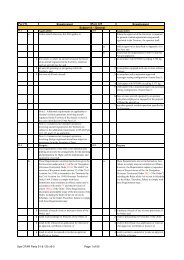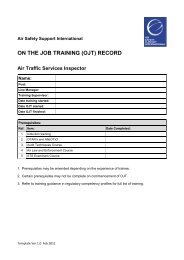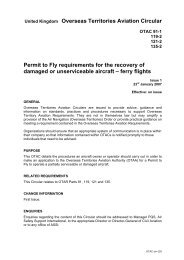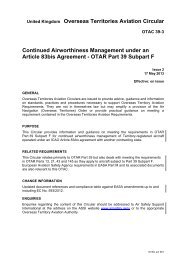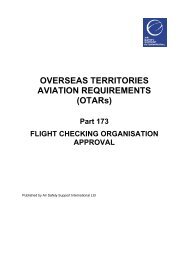Draft OTAR 39 Continued Airworthiness Requirements - Air Safety ...
Draft OTAR 39 Continued Airworthiness Requirements - Air Safety ...
Draft OTAR 39 Continued Airworthiness Requirements - Air Safety ...
Create successful ePaper yourself
Turn your PDF publications into a flip-book with our unique Google optimized e-Paper software.
OVERSEAS TERRITORIES<br />
AVIATION REQUIREMENTS<br />
(<strong>OTAR</strong>s)<br />
Part <strong>39</strong><br />
CONTINUED AIRWORTHINESS<br />
REQUIREMENTS<br />
Published by <strong>Air</strong> <strong>Safety</strong> Support International Ltd
© <strong>Air</strong> <strong>Safety</strong> Support International Limited 2004<br />
First Issue - published for information June 2004<br />
Second Issue – released for gazetting July 2005<br />
Third Issue July 2006<br />
Fourth Issue May 2007<br />
Fifth Issue May 2007<br />
Sixth Issue September 2009<br />
Seventh Issue April 2011<br />
Eighth Issue<br />
The definitive version of <strong>OTAR</strong>s is that on the ASSI website www.airsafety.aero which should<br />
be viewed to establish the issue version of each Part.<br />
Enquiries regarding the content of this publication should be addressed to:<br />
<strong>Air</strong> <strong>Safety</strong> Support International,<br />
Northgate House,<br />
115 High Street,<br />
Crawley,<br />
West Sussex,<br />
RH10 1FY<br />
United Kingdom<br />
www.airsafety.aero
<strong>Continued</strong> <strong><strong>Air</strong>worthiness</strong> <strong>Requirements</strong> Part <strong>39</strong> Page i<br />
CHECKLIST OF PAGES<br />
Page no Issue no Date<br />
Title page 7.3 April 2013<br />
Checklist of pages i 7.3 April 2013<br />
Revisions ii 7.3 April 2013<br />
Contents iii 7.3 April 2013<br />
Subpart A 1 7.3 April 2013<br />
2 7.3 April 2013<br />
Subpart B 3 7.3 April 2013<br />
4 7.3 April 2013<br />
5 7.3 April 2013<br />
6 7.3 April 2013<br />
7 7.3 April 2013<br />
8 7.3 April 2013<br />
Subpart C 9 7.3 April 2013<br />
10 7.3 April 2013<br />
11 7.3 April 2013<br />
12 7.3 April 2013<br />
Subpart D 13 7.3 April 2013<br />
14 7.3 April 2013<br />
15 7.3 April 2013<br />
16 7.3 April 2013<br />
17 7.3 April 2013<br />
Subpart E 18 7.3 April 2013<br />
19 7.3 April 2013<br />
20 7.3 April 2013<br />
Subpart F 21 7.3 April 2013<br />
<strong>Air</strong> <strong>Safety</strong> Support International (ASSI) Version 7.3 Overseas Territories Aviation <strong>Requirements</strong>
<strong>Continued</strong> <strong><strong>Air</strong>worthiness</strong> <strong>Requirements</strong> Part <strong>39</strong> Page ii<br />
REVISIONS<br />
<strong>OTAR</strong> Issue<br />
Subject<br />
Issue 1<br />
First issue published for information.<br />
Issue 2<br />
Second issue for gazetting. Change to title of Part and to<br />
Purpose statement.<br />
Issue 3<br />
Substantial revision by the inclusion of the continued<br />
airworthiness elements derived from the operational<br />
<strong>OTAR</strong>s and title change reflecting new scope of Part.<br />
Issue 4<br />
Addition of Subpart E and associated supporting<br />
amendments throughout the <strong>OTAR</strong> Part. Reordering of<br />
some paragraphs.<br />
Issue 5 Correction of cross-references <strong>39</strong>.1 and <strong>39</strong>.61.<br />
Issue 6<br />
Minor changes taking account of current airworthiness<br />
issues and consultation comments. Addition of Subpart F<br />
approval relating to foreign commercial operations of<br />
Territory-registered aircraft under an ICAO Article 83bis<br />
agreement. There are other minor changes to<br />
accommodate this new Subpart.<br />
Issue 7<br />
Introduction of quality system, Accountable Manager,<br />
removal of approval from Subpart F and minor technical<br />
and editorial changes.<br />
Issue 8<br />
<strong>39</strong>.1(g) Amended Article reference numbers to align with<br />
revision to AN(OT)O 2013.<br />
<strong>39</strong>.61 Instructions for CAW and data analysis of FDR and<br />
CVR.<br />
<strong>39</strong>.65(a) added MSG-3 logic.<br />
<strong>39</strong>.75 Retention of records periods changed in line with<br />
ICAO SARPs<br />
<strong>39</strong>.75(b)(1) deleted from <strong>OTAR</strong> Part <strong>39</strong> due to being an<br />
operational requirement.<br />
<strong>39</strong>.91(b)(1) changed to ‘approved by’.<br />
<strong>Air</strong> <strong>Safety</strong> Support International (ASSI) Version 7.3 Overseas Territories Aviation <strong>Requirements</strong>
<strong>Continued</strong> <strong><strong>Air</strong>worthiness</strong> <strong>Requirements</strong> Part <strong>39</strong> Page iii<br />
Contents<br />
CHECKLIST OF PAGES ............................................................................................................... i<br />
REVISIONS .................................................................................................................................... ii<br />
SUBPART A — GENERAL ........................................................................................................... 1<br />
<strong>39</strong>.1 PURPOSE ........................................................................................................ 1<br />
<strong>39</strong>.3 DEFINITIONS ................................................................................................... 2<br />
SUBPART B — CONTINUED AIRWORTHINESS MANAGEMENT ............................................ 3<br />
<strong>39</strong>.51 MANAGEMENT PERSONNEL .............................................................................. 3<br />
<strong>39</strong>.53 GENERAL CONTINUED AIRWORTHINESS ARRANGEMENTS .................................. 3<br />
<strong>39</strong>.55 MANAGEMENT RESPONSIBILITIES ..................................................................... 4<br />
<strong>39</strong>.57 GENERAL MAINTENANCE ARRANGEMENTS ........................................................ 6<br />
<strong>39</strong>.59 MAINTENANCE CONTROL MANUAL ................................................................... 6<br />
SUBPART C — INSPECTION REQUIREMENTS ........................................................................ 9<br />
<strong>39</strong>.61 MAINTENANCE PROGRAMME ............................................................................ 9<br />
<strong>39</strong>.63 MAINTENANCE PROGRAMME APPROVAL ........................................................... 11<br />
<strong>39</strong>.65 CONDITION MONITORED AND RELIABILITY MAINTENANCE PROGRAMMES ............. 11<br />
<strong>39</strong>.67 AIRWORTHINESS DIRECTIVES APPLICABILITY .................................................... 12<br />
<strong>39</strong>.69 AIRWORTHINESS DIRECTIVES COMPLIANCE ...................................................... 12<br />
<strong>39</strong>.70 CONTINUED AIRWORTHINESS IMPROVEMENTS .................................................. 12<br />
<strong>39</strong>.71 ALTERNATIVE MEANS OF COMPLIANCE WITH MANDATORY CONTINUED<br />
AIRWORTHINESS REQUIREMENTS ..................................................................... 12<br />
SUBPART D — AIRCRAFT RECORDS ....................................................................................... 13<br />
<strong>39</strong>.73 MAINTENANCE AND CONTINUED AIRWORTHINESS RECORDS .............................. 13<br />
<strong>39</strong>.75 RETENTION OF RECORDS ................................................................................. 14<br />
<strong>39</strong>.77 TRANSFER OF MAINTENANCE RECORDS ............................................................ 15<br />
<strong>39</strong>.79 TECHNICAL LOG .............................................................................................. 15<br />
<strong>39</strong>.81 MASS AND BALANCE ........................................................................................ 16<br />
<strong>39</strong>.83 ALTERNATIVE CONFIGURATIONS....................................................................... 17<br />
<strong>39</strong>.85 CERTIFICATION ............................................................................................... 17<br />
SUBPART E — CONTINUED AIRWORTHINESS MANAGEMENT APPROVAL ....................... 18<br />
<strong>39</strong>.87 APPLICABILITY ................................................................................................. 18<br />
<strong>39</strong>.89 STANDARDS .................................................................................................... 18<br />
<strong>39</strong>.91 ISSUE ............................................................................................................. 18<br />
<strong>39</strong>.93 PRIVILEGES OF APPROVAL HOLDER .................................................................. 19<br />
<strong>39</strong>.95 DURATION OF APPROVAL ................................................................................. 19<br />
<strong>39</strong>.97 NOTIFICATION OF CEASING APPROVAL ACTIVITY ................................................ 19<br />
<strong>39</strong>.99 RENEWAL OF APPROVAL .................................................................................. 19<br />
<strong>39</strong>.101 CONTINUED COMPLIANCE ................................................................................ 19<br />
SUBPART F — CONTINUED AIRWORTHINESS MANAGEMENT IN ASSOCIATION WITH AN ICAO<br />
ARTICLE 83BIS AGREEMENT .................................................................................................... 21<br />
<strong>39</strong>.103 APPLICABILITY ................................................................................................. 21<br />
<strong>39</strong>.105 STANDARDS .................................................................................................... 21<br />
<strong>39</strong>.107 COMPLIANCE ................................................................................................... 21<br />
<strong>Air</strong> <strong>Safety</strong> Support International (ASSI) Version 7.3 Overseas Territories Aviation <strong>Requirements</strong>
<strong>Continued</strong> <strong><strong>Air</strong>worthiness</strong> <strong>Requirements</strong> Part <strong>39</strong> Page 1<br />
Subpart A — General<br />
<strong>39</strong>.1 Purpose<br />
(a)<br />
(b)<br />
(c)<br />
This Part details requirements governing aircraft registered in the Territory<br />
and issued with an airworthiness certificate under <strong>OTAR</strong> Part 21<br />
Subpart E and any aeronautical product associated with those aircraft.<br />
The holder of an air operator’s certificate or the owner or lessee of an<br />
aircraft above 2,700 kg MTOM shall have arrangements for continued<br />
airworthiness management in accordance with the requirements of<br />
Subpart E of this <strong>OTAR</strong> Part.<br />
The requirements of this <strong>OTAR</strong> Part cover the grant and renewal of<br />
continued airworthiness inspection programmes and management<br />
approvals. These are the approval options under this <strong>OTAR</strong> Part:<br />
(1) Subpart E Option 1: the approval of an organisation based on the<br />
acceptance of the European Aviation <strong>Safety</strong> Agency (EASA)<br />
requirements of Part M Subpart G and the EASA regulatory<br />
oversight of that organisation.<br />
(2) Subpart E Option 2: the approval of an organisation that does not<br />
hold an approval identified in paragraph <strong>39</strong>.1(c)(1).<br />
(d)<br />
(e)<br />
(f)<br />
Subpart F is a standard of continued airworthiness management required<br />
for Territory-registered aircraft operating under a foreign air operator<br />
certificate and subject to an ICAO Article 83bis agreement with the<br />
Territory.<br />
Throughout this <strong>OTAR</strong> Part reference is made to the options identified in<br />
paragraph <strong>39</strong>.1(c)(1) and (2). The options are not at the discretion of an<br />
applicant but are routes that depend on the existing approval status of an<br />
organisation and are determined by the Governor.<br />
These requirements are not in themselves Law. Failure to comply may not<br />
constitute an offence. However, the requirements reproduce many of the<br />
provisions of the <strong>Air</strong> Navigation (Overseas Territories) Order (as<br />
amended) (“the Order”). Therefore, failure to comply with these<br />
<strong>Requirements</strong> may:<br />
(1) constitute a breach of the Order; and<br />
(2) result in proceedings for breaches of the Order; or<br />
(3) result in the refusal of an application for renewal of an approval; or<br />
(4) result in action to suspend or revoke an approval.<br />
(g)<br />
The Order details the legal obligations governing the continued<br />
airworthiness of aircraft on the Territory’s register. The Order specifies<br />
these obligations in rather general terms, therefore there is a provision in<br />
Article 5 and 74 to the Order which requires the Governor to publish<br />
<strong>Requirements</strong> to augment amplify and detail more precisely the manner in<br />
<strong>Air</strong> <strong>Safety</strong> Support International (ASSI) Version 7.3 Overseas Territories Aviation <strong>Requirements</strong>
<strong>Continued</strong> <strong><strong>Air</strong>worthiness</strong> <strong>Requirements</strong> Part <strong>39</strong> Page 2<br />
which these obligations shall be met. The <strong>Requirements</strong> are the means by<br />
which the operator or maintenance organisation will be able to satisfy the<br />
Governor as to the fulfilment of the obligations in respect of continued<br />
airworthiness and the entitlement of the holder to hold and exercise the<br />
privileges of a certificate, licence or approval.<br />
(h)<br />
(i)<br />
Other <strong>OTAR</strong> Parts, in addition to that referred to in this Part, may impinge<br />
upon activities conducted under this Part. In particular, Part 1 contains<br />
definitions, which apply, unless otherwise stated, to all Parts. A full list of<br />
<strong>OTAR</strong> Parts, a description of the legislative structure and the place of<br />
<strong>OTAR</strong>s and OTACs within it can be viewed on the ASSI website<br />
www.airsafety.aero. OTACs relevant to this Part can be viewed at:<br />
http://www.airsafety.aero/legislation_and_otar_s/otac_s/.<br />
References to the Governor in this <strong>OTAR</strong> Part mean the regulator<br />
designated by the Governor of the Territory to exercise his functions under<br />
the Order.<br />
<strong>39</strong>.3 Definitions<br />
Definitions, in the context of this Part of the <strong>OTAR</strong>s shall have the meanings<br />
listed in <strong>OTAR</strong> Part 1 (Definitions, Abbreviations and Units of Measurement);<br />
except that:<br />
Principal Contract means a contract established to discharge all functional<br />
responsibilities of continued airworthiness management to an organisation<br />
appropriately approved under this <strong>OTAR</strong> Part.<br />
<strong>Air</strong> <strong>Safety</strong> Support International (ASSI) Version 7.3 Overseas Territories Aviation <strong>Requirements</strong>
<strong>Continued</strong> <strong><strong>Air</strong>worthiness</strong> <strong>Requirements</strong> Part <strong>39</strong> Page 3<br />
Subpart B — <strong>Continued</strong> <strong><strong>Air</strong>worthiness</strong> Management<br />
<strong>39</strong>.51 Management personnel<br />
(a)<br />
(b)<br />
(c)<br />
Except where provided in paragraph <strong>39</strong>.51(b), the owner or, where it is<br />
leased, the lessee of an aircraft registered in the Territory shall appoint a<br />
person acceptable to the Governor and known as the Technical Coordinator<br />
who will ensure that appropriate arrangements for continued<br />
airworthiness management required by this <strong>OTAR</strong> Part are in place.<br />
Each holder of an air operator’s certificate shall appoint a post holder<br />
under the requirements of <strong>OTAR</strong> Part 119 within its organisation who will<br />
be responsible for the continued airworthiness management of the<br />
operator’s aircraft as required by this <strong>OTAR</strong> Part.<br />
The appointed post-holder for continued airworthiness of Territory<br />
registered aircraft operating under a foreign air operator’s certificate and<br />
the provisions of an ICAO Article 83bis agreement shall establish and<br />
maintain arrangements for the continued airworthiness management of<br />
the Territory registered aircraft as required by Subpart F of this <strong>OTAR</strong><br />
Part.<br />
<strong>39</strong>.53 General continued airworthiness arrangements<br />
(a)<br />
(b)<br />
The holder of an air operator’s certificate or the owner or lessee of an<br />
aircraft above 2,700 kg MTOM shall have arrangements for continued<br />
airworthiness management to the requirements of Subpart E of this Part.<br />
The Technical Co-ordinator identified in paragraph <strong>39</strong>.51(a) shall ensure<br />
that suitable arrangements for continued airworthiness management by<br />
either:<br />
(1) holding an approval granted by the Governor to the requirements of<br />
Subpart E of this Part; or<br />
(2) a Principal Contract between the operator and an organisation that<br />
holds an appropriate approval granted by the Governor to the<br />
requirements of Subpart E of this Part.<br />
(c)<br />
The person identified in <strong>39</strong>.51(b) shall ensure that suitable arrangements<br />
for continued airworthiness management are in place by either:<br />
(1) the AOC holder being approved by the Governor to the<br />
requirements of Subpart E of this Part; or<br />
(2) a Principal Contract between the AOC holder and an organisation<br />
that holds an appropriate approval granted by the Governor to the<br />
requirements of Subpart E of this Part.<br />
(d)<br />
The appointed post-holder identified in <strong>39</strong>.51(c) shall ensure that suitable<br />
arrangements for continued airworthiness management are in place to a<br />
standard equivalent to Subpart F of this Part.<br />
<strong>Air</strong> <strong>Safety</strong> Support International (ASSI) Version 7.3 Overseas Territories Aviation <strong>Requirements</strong>
<strong>Continued</strong> <strong><strong>Air</strong>worthiness</strong> <strong>Requirements</strong> Part <strong>39</strong> Page 4<br />
<strong>39</strong>.55 Management responsibilities<br />
The personnel identified in paragraph <strong>39</strong>.51 are responsible for ensuring that<br />
the certificate of airworthiness continues to remain valid by suitable<br />
arrangements made in accordance with in paragraph <strong>39</strong>.53 that also ensure<br />
that:<br />
(a)<br />
the aircraft, including its airframe, engines(s), propellers, appliances,<br />
emergency equipment and operational equipment, is maintained in an<br />
airworthy condition; and<br />
(b) all scheduled maintenance is performed in accordance with a<br />
maintenance programme approved by the Governor; and<br />
(c)<br />
(d)<br />
(e)<br />
appropriate contracted maintenance arrangements are made acceptable<br />
to the Governor; and<br />
no person certifies maintenance on the aircraft other than as prescribed in<br />
<strong>OTAR</strong> Part 43; and<br />
any defects and unserviceabilities are rectified or deferred in accordance<br />
with <strong>OTAR</strong> Part 91.610(a) prior to flight or, as permitted by <strong>OTAR</strong> Part<br />
91.610(b), are rectified, repaired or, where approved data so provides, the<br />
equipment/instrument is removed at or before the next inspection required<br />
by the applicable approved maintenance programme; and<br />
(1) as applicable for aircraft subject to reliability analysis, a verification<br />
of the associated aircraft system’s functional reliability is undertaken<br />
to ensure the certification basis of the MEL/CDL is not<br />
compromised; and<br />
(2) repetitive defects are identified and controlled in accordance with<br />
procedures approved in the maintenance control manual; and<br />
(3) procedures are in place for the notification of any MEL/CDL<br />
limitations to the operating crew; and<br />
(4) procedures are established for the subsequent control of required<br />
rectification intervals; and<br />
(f)<br />
(g)<br />
applicable mandatory continued airworthiness requirements are complied<br />
with within the prescribed period; and<br />
for all turbine powered aircraft:<br />
(1) there are suitable arrangements for the receipt of all relevant<br />
continued airworthiness information published by the Type Design<br />
Organisation’s for the aircraft and any applicable accomplished<br />
major design change; and<br />
(2) any required technical and reliability assessments are undertaken<br />
and reports of aircraft continued airworthiness status are made by<br />
arrangements acceptable to the Governor; and<br />
<strong>Air</strong> <strong>Safety</strong> Support International (ASSI) Version 7.3 Overseas Territories Aviation <strong>Requirements</strong>
<strong>Continued</strong> <strong><strong>Air</strong>worthiness</strong> <strong>Requirements</strong> Part <strong>39</strong> Page 5<br />
(3) applicable continued airworthiness data is reviewed for the<br />
determination of any required actions to be taken and records of<br />
such reviews are maintained; and<br />
(h) repairs are carried out and approved in accordance with <strong>OTAR</strong> Part 21<br />
Subpart M that, wherever possible, do not impose further continued<br />
airworthiness requirements; and<br />
(i)<br />
(j)<br />
(k)<br />
(l)<br />
(m)<br />
(n)<br />
design changes are carried out and approved in accordance with <strong>OTAR</strong><br />
Part 21 Subpart C and any continued airworthiness requirements arising<br />
from them are incorporated in the aircraft maintenance programme; and<br />
suitable arrangements, acceptable to the Governor, are made for the<br />
regular development of the maintenance programme to ensure effective<br />
continued airworthiness of the applicable aircraft; and<br />
any applicable continued airworthiness data is made available to those<br />
involved in the maintenance of the aircraft; and<br />
procedures prescribed in any applicable maintenance control manual are<br />
complied with; and<br />
any required technical despatch procedures for special operations<br />
approved by the Governor are complied with; and<br />
for any aircraft having systems utilising Field Loadable Software and<br />
Database Field Loadable Data, controlling procedures acceptable to the<br />
Governor are in place to ensure that:<br />
(1) Field Loadable Software uploads are accomplished in accordance<br />
with the approval requirements of <strong>OTAR</strong> Part 21 Subpart C; and<br />
(2) Database Field Loadable Data is controlled and transferred in<br />
accordance with the equipment manufacturer’s instructions; and<br />
(o)<br />
(p)<br />
(q)<br />
(r)<br />
(s)<br />
continued airworthiness records are maintained in accordance with<br />
Subpart D of this <strong>OTAR</strong> Part; and<br />
occurrence reporting is accomplished to the requirements of <strong>OTAR</strong><br />
Part 13 and appropriate investigations are undertaken to safeguard the<br />
aircraft and that of any other, records of such investigations any actions<br />
taken shall be reported as required by <strong>OTAR</strong> Part 13; and<br />
where applicable, there are suitable procedures acceptable to the<br />
Governor for the control of aircraft, product and component leasing; and<br />
up-to-date mass and balance records are maintained that reflect the<br />
approved configuration of the aircraft; and<br />
arrangements are made for technical liaison with applicable type design<br />
organisations, operators and maintenance organisations to address any<br />
airworthiness issues such as faults, malfunctions, defects, any required<br />
inspection task reporting and inaccurate/misleading airworthiness data;<br />
and<br />
<strong>Air</strong> <strong>Safety</strong> Support International (ASSI) Version 7.3 Overseas Territories Aviation <strong>Requirements</strong>
<strong>Continued</strong> <strong><strong>Air</strong>worthiness</strong> <strong>Requirements</strong> Part <strong>39</strong> Page 6<br />
(t)<br />
liaison meetings are held in compliance with any applicable reliability<br />
monitoring programme requirement.<br />
<strong>39</strong>.57 General maintenance arrangements<br />
(a)<br />
Arrangements for maintenance of aircraft above 2,700kg MTOM required<br />
by paragraph <strong>39</strong>.55(c) shall be established by a suitable contract:<br />
(1) with an appropriately approved <strong>OTAR</strong> Part 145 maintenance<br />
organisation; and<br />
(2) where applicable, to the requirements of <strong>OTAR</strong> Part 43.101(a) and<br />
(b).<br />
(b)<br />
(c)<br />
The annual maintenance check or that specified in the approved<br />
maintenance programme for aircraft below 2,700kg MTOM shall be<br />
undertaken by an appropriately approved <strong>OTAR</strong> Part 145 maintenance<br />
organisation.<br />
The maintenance contract shall specify:<br />
(1) a clear description of the work required of the maintenance<br />
organisation or person that takes account of human factors; and<br />
(2) that a fatigue management system shall be in place to ensure that<br />
any person involved in the maintenance of the operator’s aircraft is<br />
not fatigued; and<br />
(3) the applicable Maintenance Control Manual including any operator<br />
specific maintenance control procedures that are to be followed; and<br />
(4) the operator contact information; and<br />
(5) details of any supplied maintenance data including its revision status<br />
and applicability.<br />
(d)<br />
(e)<br />
Persons signing a Certificate of Release to Service shall be appropriately<br />
authorised in accordance with the requirements specified in <strong>OTAR</strong> Part 43<br />
Subpart C.<br />
<strong>Air</strong>craft to be operated under a Permit to Fly granted by the Governor<br />
under the requirements of <strong>OTAR</strong> Part 21 Subpart P shall have<br />
maintenance arrangements acceptable to the Governor as required by<br />
that <strong>OTAR</strong> Subpart.<br />
<strong>39</strong>.59 Maintenance Control Manual<br />
(a)<br />
The Maintenance Control Manual forms the basis for an approval<br />
prescribed in <strong>39</strong>.89(a) and (b) and is subject to approval by the Governor.<br />
It shall be in the English language; the content shall be representative of<br />
the organisation and it shall address compliance with the applicable<br />
requirements of this <strong>OTAR</strong> Part.<br />
<strong>Air</strong> <strong>Safety</strong> Support International (ASSI) Version 7.3 Overseas Territories Aviation <strong>Requirements</strong>
<strong>Continued</strong> <strong><strong>Air</strong>worthiness</strong> <strong>Requirements</strong> Part <strong>39</strong> Page 7<br />
(b) Where an organisation is approved under the requirements of Option 1<br />
identified in paragraph <strong>39</strong>.89(a), combined organisation documents such<br />
as EASA CAME may be acceptable provided suitable cross references to<br />
the requirements of this <strong>OTAR</strong> Part are provided.<br />
(c)<br />
(d)<br />
The Maintenance Control Manual shall contain details of the accountable<br />
manager and a corporate commitment to compliance with applicable<br />
<strong>OTAR</strong>s.<br />
The Maintenance Control Manual shall be approved by the Governor and<br />
amendments shall be either:<br />
(1) approved by the Governor; or<br />
(2) be approved by the organisation in accordance with a procedure<br />
approved by the Governor; and<br />
(3) be made available to personnel at all locations where access to that<br />
material may be required either in hard copy or electronic format in a<br />
manner acceptable to the Governor.<br />
(e)<br />
(f)<br />
(g)<br />
The Maintenance Control Manual shall take account of human factors, a<br />
fatigue management system and contain details of continuation training<br />
for all personnel involved in airworthiness management.<br />
The Maintenance Control Manual shall contain the necessary procedures<br />
for applicable continued airworthiness management functions prescribed<br />
in paragraph <strong>39</strong>.55 and <strong>39</strong>.57 to ensure the continued airworthiness of the<br />
managed aircraft and ensure the continued validity of the Certificates of<br />
<strong><strong>Air</strong>worthiness</strong>.<br />
The organisation shall establish a safety and quality policy for the<br />
organisation to be included in the MCM that shall detail:<br />
(1) a quality system that includes independent audits to monitor the<br />
adequacy of procedures and to ensure that the organisation<br />
functional responsibilities are discharged effectively; and<br />
(2) a quality feedback reporting system to the person or group of<br />
persons specified in paragraph <strong>39</strong>.59(k)(2) and ultimately to the<br />
accountable manager; and<br />
(3) procedures to ensure that proper and timely corrective action is<br />
taken in response to reports resulting from the independent audits.<br />
(h)<br />
(i)<br />
(j)<br />
in small organisations of fewer than 5 people the independent audit part of<br />
the quality system may be contracted to another Part <strong>39</strong> approved<br />
organisation or a person with appropriate technical knowledge and proven<br />
satisfactory audit experience, in a manner acceptable to the Governor.<br />
Procedures shall be established for a regular review of the MCM to ensure<br />
that it remains effective in maintaining aircraft in an airworthy condition.<br />
All amendments shall be made in a timely manner and the amendment<br />
status of each document shall be readily identifiable by personnel.<br />
Obsolete material shall be removed promptly from all points of issue or<br />
<strong>Air</strong> <strong>Safety</strong> Support International (ASSI) Version 7.3 Overseas Territories Aviation <strong>Requirements</strong>
<strong>Continued</strong> <strong><strong>Air</strong>worthiness</strong> <strong>Requirements</strong> Part <strong>39</strong> Page 8<br />
use, and controls shall be in place to preclude the use by personnel of<br />
superseded material.<br />
(k)<br />
The Maintenance Control Manual shall contain details of:<br />
(1) the available facilities; and<br />
(2) personnel including their duties and responsibilities; and<br />
(3) any computer based systems and data to be utilised for the purpose<br />
of continued airworthiness management.<br />
(l) The Maintenance Control Manual shall contain details of any<br />
subcontracted activities.<br />
(m)<br />
(n)<br />
(o)<br />
(p)<br />
Where the organisation is to be approved for the purpose of undertaking<br />
an aircraft airworthiness review required by <strong>OTAR</strong> Part 21.175(c), detailed<br />
procedures shall be established for compiling suitable reports to the<br />
Governor and shall include the identification of personnel authorised to<br />
submit such reports.<br />
The Maintenance Control Manual shall contain details of personnel<br />
nominated to certify an airworthiness status report as required by <strong>OTAR</strong><br />
Part 21.175(e) in relation to the C of A.<br />
The capability and scope of the approval shall be recorded in the MCM.<br />
The Maintenance Control Manual shall contain a list of definitions and<br />
acronyms used.<br />
<strong>Air</strong> <strong>Safety</strong> Support International (ASSI) Version 7.3 Overseas Territories Aviation <strong>Requirements</strong>
<strong>Continued</strong> <strong><strong>Air</strong>worthiness</strong> <strong>Requirements</strong> Part <strong>39</strong> Page 9<br />
Subpart C — Inspection <strong>Requirements</strong><br />
<strong>39</strong>.61 Maintenance programme<br />
(a)<br />
(b)<br />
(c)<br />
(d)<br />
(e)<br />
(f)<br />
<strong>Air</strong>craft granted a certificate of airworthiness under the requirements of<br />
<strong>OTAR</strong> Part 21 Subpart E shall be maintained in accordance with a<br />
maintenance programme approved by the Governor.<br />
The maintenance programme and any amendments shall require approval<br />
by the Governor for each aircraft, and shall include details of the<br />
maintenance of the aircraft, engines, propellers, rotors, appliances and<br />
emergency equipment items.<br />
The maintenance programme shall reference the required inspection<br />
standards, practices and procedures that shall be at least equivalent to<br />
the Type Certificate holder’s scheduled maintenance requirements.<br />
Any schedule of inspections/tests required by any approved programme<br />
amendment shall be introduced in a controlled manner to ensure the<br />
continued airworthiness of the aircraft.<br />
Consideration shall be given to human performance within the<br />
maintenance programme including the format of the maintenance<br />
programme document, maintenance task breakdown and combined<br />
maintenance tasking, particularly safety critical tasks which shall be<br />
identified in the maintenance programme.<br />
The maintenance programme shall readily identify any certification<br />
inspection tasks and other significant continued airworthiness inspection<br />
tasks that are the subject of specific control and mandated by the<br />
applicable State of Type Certification, as referred to in <strong>OTAR</strong> Part<br />
21.19(a), such as but not limited to:<br />
(1) Supplemental Structural Inspection Document;<br />
(2) Fuel Tank <strong>Safety</strong> Inspections;<br />
(3) Ageing <strong>Air</strong>craft;<br />
(4) Widespread Fatigue Damage;<br />
(5) Electrical Wiring Interconnection Systems (EWIS).<br />
(g)<br />
Each maintenance programme approval holder shall make any revisions<br />
to the maintenance programme as required by the Governor and any<br />
applicable mandatory amendments promulgated by the Type Certificate<br />
holder or its NAA to satisfy the continuing airworthiness requirements for<br />
the aircraft.<br />
<strong>Air</strong> <strong>Safety</strong> Support International (ASSI) Version 7.3 Overseas Territories Aviation <strong>Requirements</strong>
<strong>Continued</strong> <strong><strong>Air</strong>worthiness</strong> <strong>Requirements</strong> Part <strong>39</strong> Page 10<br />
(h)<br />
The maintenance programme including any amendments shall be<br />
produced in the English language, be readily available and shall contain<br />
within it:<br />
(1) an explanation of the programme, including the continuity of<br />
inspection responsibility, procedures for making any required reports<br />
and technical reference material; and<br />
(2) instructions and procedures for the implementation of inspection<br />
tasks for the particular aircraft type, taking account of the aircraft<br />
modification status and any repairs that have associated instructions<br />
for continued airworthiness; and<br />
(3) an inspection schedule for performing the inspections required by<br />
the programme expressed in terms of the total time in service,<br />
cycles, calendar time, number of system operations, or any<br />
combination of these; and<br />
(4) for a progressive inspection programme, an inspection schedule that<br />
provides for the complete inspection of the aircraft within each 12<br />
month period or is consistent with:<br />
(i)<br />
(ii)<br />
(iii)<br />
(iv)<br />
the manufacturer’s recommendations; and<br />
the operator’s service experience; and<br />
the type of operation in which the aircraft is engaged; and<br />
the utilisation of the aircraft in terms of hours and cycles or a<br />
combination thereof.<br />
(5) instructions taking account of detailed technical justification, for<br />
altering and gaining approval for a change of inspection intervals or<br />
a maintenance process because of service experience; and<br />
(6) instructions for varying an inspection interval under exceptional<br />
circumstances taking account of overriding mandatory requirements<br />
and maintenance programme inspection requirements referred to in<br />
paragraphs <strong>39</strong>.61(e) and (f); and<br />
(7) sample inspection forms, reports and instructions for their use; and<br />
(8) procedures for maintenance trend analysis if the programme utilises<br />
condition monitored maintenance or information derived from health<br />
and usage monitoring systems; and<br />
(9) inspection requirements required for approved special operations;<br />
and<br />
(10) instructions for continued airworthiness including inspection and<br />
analysis of any installed Flight Data Recorder (FDR) and/or Cockpit<br />
Voice Recorder (CVR) in accordance with instructions from the Type<br />
Certificate holder. If the Type Certificate holder has not provided<br />
specific requirements, the limitations specified in ICAO Annex 6 Part<br />
I, II, or III, as applicable shall prevail.<br />
(11) a list of definitions and acronyms used.<br />
<strong>Air</strong> <strong>Safety</strong> Support International (ASSI) Version 7.3 Overseas Territories Aviation <strong>Requirements</strong>
<strong>Continued</strong> <strong><strong>Air</strong>worthiness</strong> <strong>Requirements</strong> Part <strong>39</strong> Page 11<br />
<strong>39</strong>.63 Maintenance programme approval<br />
(a)<br />
(b)<br />
Each applicant for the approval of a maintenance programme shall apply<br />
to the Governor for approval.<br />
The application for approval of the maintenance programme shall contain,<br />
or references shall be made to, the following information:<br />
(1) the name and address of the owner or lessee or the holder of an air<br />
operator’s certificate; and<br />
(2) the maintenance status of the aircraft prior to the commencement of<br />
the programme; and<br />
(3) the means of introducing the programme; and<br />
(4) technical justification relating to the anticipated utilisation of the<br />
aircraft, inspection intervals and procedures for inspection task<br />
management; and<br />
(5) a copy of the maintenance programme either in hard copy or<br />
electronic format in a manner acceptable to the Governor; and<br />
(6) copies of any other supporting documents, such as condition<br />
monitored maintenance activities, structural integrity programmes,<br />
engine off-wing maintenance programmes, fuel tank safety<br />
inspection programmes; and<br />
(7) the aircraft designation, serial number and registration mark for each<br />
aircraft that is subject to the programme; and<br />
(8) any further particulars relating to the programme and applicant as<br />
may be required by the Governor.<br />
<strong>39</strong>.65 Condition monitored and reliability maintenance<br />
programmes<br />
(a)<br />
(b)<br />
(c)<br />
Where the manufacturer of aircraft, engines and propellers prescribe<br />
MSG-3 logic, condition monitoring, or health and usage monitoring<br />
systems these shall form part of the maintenance programme approved<br />
by the Governor under paragraph <strong>39</strong>.63.<br />
Appropriate procedures acceptable to the Governor shall be established<br />
for any applicable condition monitoring or reliability or health and usage<br />
monitoring systems referred to in paragraph <strong>39</strong>.65(a).<br />
Where data gathering is required, the following shall form the basis of an<br />
acceptable programme:<br />
(1) aircraft utilisation; and<br />
(2) pilot reports; and<br />
(3) aircraft mechanical delays and cancellations; and<br />
<strong>Air</strong> <strong>Safety</strong> Support International (ASSI) Version 7.3 Overseas Territories Aviation <strong>Requirements</strong>
<strong>Continued</strong> <strong><strong>Air</strong>worthiness</strong> <strong>Requirements</strong> Part <strong>39</strong> Page 12<br />
(4) unscheduled engine shutdowns; and<br />
(5) unscheduled engine removals; and<br />
(6) unscheduled component removals; and<br />
(7) confirmed component failures; and<br />
(8) occurrences.<br />
<strong>39</strong>.67 <strong><strong>Air</strong>worthiness</strong> Directives applicability<br />
(a)<br />
Except as provided for in paragraph <strong>39</strong>.67(b), the airworthiness directives<br />
applicable under this Part are those airworthiness directives or equivalent<br />
mandatory continued airworthiness requirements:<br />
(1) prescribed for that aircraft or product by the State of type<br />
certification on which Type Acceptance Certification rests; and<br />
(2) any prescribed by the state of certification of an applicable approved<br />
design change.<br />
(b)<br />
Compliance with alternative or additional airworthiness directives may be<br />
required as a condition of issue or continuity of the Type Acceptance<br />
Certificate.<br />
<strong>39</strong>.69 <strong><strong>Air</strong>worthiness</strong> Directives compliance<br />
An aircraft shall not be released to service unless for each applicable<br />
airworthiness directive:<br />
(a)<br />
(b)<br />
compliance can be demonstrated with the specified compliance criteria; or<br />
an alternative means of compliance has been approved under paragraph<br />
<strong>39</strong>.71.<br />
<strong>39</strong>.70 <strong>Continued</strong> airworthiness improvements<br />
An aircraft holding a Certificate of <strong><strong>Air</strong>worthiness</strong> granted in the Territory shall<br />
comply with the special conditions of Type Acceptance referred to in <strong>OTAR</strong><br />
Part 21.19(a) for any additional requirements of continued airworthiness.<br />
<strong>39</strong>.71 Alternative means of compliance with mandatory<br />
continued airworthiness requirements<br />
An alternative means of compliance may be proposed for the Governor’s<br />
approval provided that the regulatory authority of the Contracting State that<br />
issued the original requirement has accepted the alternative compliance<br />
proposal.<br />
<strong>Air</strong> <strong>Safety</strong> Support International (ASSI) Version 7.3 Overseas Territories Aviation <strong>Requirements</strong>
<strong>Continued</strong> <strong><strong>Air</strong>worthiness</strong> <strong>Requirements</strong> Part <strong>39</strong> Page 13<br />
Subpart D — <strong>Air</strong>craft Records<br />
<strong>39</strong>.73 Maintenance and continued airworthiness records<br />
(a)<br />
The owner or, where it is leased, the lessee of an aircraft or the holder of<br />
an air operator’s certificate shall make provision for the retention of aircraft<br />
engine and propeller log books recording at least the following:<br />
(1) maintenance records; and<br />
(2) airworthiness records of compliance with airworthiness directives<br />
and scheduled maintenance requirements; and<br />
(3) records of modifications and repairs; and<br />
(4) life component records.<br />
(b)<br />
(c)<br />
Maintenance records shall be of sufficient detail to establish the full<br />
content of the maintenance activity undertaken and shall include all<br />
relevant supporting information, such as component replacement service<br />
life records.<br />
Records shall be of sufficient detail to demonstrate the airworthiness<br />
status of the aircraft at all times and shall include:<br />
(1) a description of maintenance tasks including references to the<br />
applicable approved technical data; and<br />
(2) the date of completion of all scheduled maintenance tasks and<br />
reference to the approved maintenance programme; and<br />
(3) the signature, and authorisation reference of the person certifying<br />
the aircraft for return to service; and<br />
(4) the total time in service by the specified time control basis of the<br />
airframe, each engine, each propeller, and each rotor and installed<br />
equipment; and<br />
(5) the current status of lifed parts/components of each airframe,<br />
engine, propeller, rotor and appliance with referenced to the<br />
specified time interval basis required by paragraph <strong>39</strong>.61(h)(3); and<br />
(6) the time since last overhaul of all items installed on the aircraft which<br />
are required to be overhauled on a specified time basis; and<br />
(7) the current maintenance status of the aircraft, including the time<br />
since the last inspection required by the maintenance programme<br />
under which the aircraft is maintained; and<br />
(8) the current status of each applicable airworthiness directive<br />
including:<br />
(i)<br />
(ii)<br />
the airworthiness directive number; and<br />
the revision date; and<br />
<strong>Air</strong> <strong>Safety</strong> Support International (ASSI) Version 7.3 Overseas Territories Aviation <strong>Requirements</strong>
<strong>Continued</strong> <strong><strong>Air</strong>worthiness</strong> <strong>Requirements</strong> Part <strong>39</strong> Page 14<br />
(iii)<br />
(iv)<br />
the means of compliance; and<br />
and if the airworthiness directive involves recurring action, the<br />
time and date when the next action is required; and<br />
(9) a list of all design changes and repairs to each airframe, engine,<br />
propeller, rotor and appliance including substantiation data required<br />
by <strong>OTAR</strong> Part 21.73(c); and<br />
(10) a record of all airframe damage that shows each damage site with a<br />
reference to a certified assessment to approved data supporting<br />
continued aircraft operation; and<br />
(11) a record of any defects or maintenance activities requiring<br />
rectification action to restore the aircraft to an airworthy condition.<br />
(d)<br />
The records shall be kept in hard copy form or in electronic coded form<br />
provided that this form allows for the preservation and retrieval of<br />
information in a manner acceptable to the Governor.<br />
(e) Any additional worksheets, documents, technical logs or other<br />
documentation associated with the maintenance of the aircraft shall be<br />
referenced in the relevant log books and will become part of the<br />
maintenance records for retention of records purposes.<br />
<strong>39</strong>.75 Retention of records<br />
(a)<br />
The owner or where it is leased the lessee of an aircraft or the holder of<br />
an air operator’s certificate shall retain maintenance and continued<br />
airworthiness records for at least the following specified periods:<br />
(1) for a minimum period of 90 days after the unit to which they refer<br />
has been permanently withdrawn from service:<br />
(i)<br />
(ii)<br />
(iii)<br />
(iv)<br />
(v)<br />
the total time in service (hours, calendar time and cycles, as<br />
appropriate) of the aeroplane and all life-limited components;<br />
the current status of compliance with all mandatory continuing<br />
airworthiness information;<br />
appropriate details of modifications and repairs;<br />
the time in service (hours, calendar time and cycles, as<br />
appropriate) since the last overhaul of the aeroplane or its<br />
components subject to a mandatory overhaul life;<br />
the current status of the aeroplane’s compliance with the<br />
maintenance programme<br />
(2) for a minimum period of one year after the signing of the<br />
maintenance release:<br />
(i) the detailed maintenance records to show that all<br />
requirements for the signing of a maintenance release have<br />
been met.<br />
<strong>Air</strong> <strong>Safety</strong> Support International (ASSI) Version 7.3 Overseas Territories Aviation <strong>Requirements</strong>
<strong>Continued</strong> <strong><strong>Air</strong>worthiness</strong> <strong>Requirements</strong> Part <strong>39</strong> Page 15<br />
(b)<br />
The owner or, where it is leased, the lessee of an aircraft or the holder of<br />
an air operator’s certificate required by paragraph <strong>39</strong>.79(a) to provide a<br />
Technical Log shall ensure that arrangements are established for the<br />
subsequent transmittal of sector record pages to the organisation<br />
responsible for the continued airworthiness of the aircraft.<br />
<strong>39</strong>.77 Transfer of maintenance records<br />
(a)<br />
(b)<br />
Each holder of a Territory Certificate of Registration for an aircraft<br />
transferring registration to another person under <strong>OTAR</strong> Part 47 shall, at<br />
the time of transfer of registration, transfer to that person all relevant<br />
maintenance records and records of continued airworthiness.<br />
In the event of a temporary change of operator, the relevant maintenance<br />
records and records of continued airworthiness shall be made available to<br />
the new operator.<br />
<strong>39</strong>.79 Technical log<br />
(a)<br />
The holder of an air operator’s certificate, owner or where it is leased the<br />
lessee of an aircraft above 2,700 kg MTOM or turbine powered shall<br />
provide a technical log for the aircraft which has provision for recording:<br />
(1) the name of the operator; and<br />
(2) the registration and designation of the aircraft; and<br />
(3) record of aircraft utilisation including total time (daily, hours, cycles<br />
sectors) as applicable; and<br />
(4) records of fuel and oil; and<br />
(5) the maintenance status of the aircraft, the identity of the next<br />
scheduled inspection, including date/hours/cycles at which any other<br />
out of phase maintenance/inspection is required; and<br />
(6) any defects or abnormal occurrences found by the pilot during or<br />
following a flight; and details of rectification of defects occurring<br />
between scheduled inspections including the certificate of release to<br />
service for any rectification; and<br />
(7) details of any deferred rectification including any inoperative<br />
equipment with which the aircraft is permitted to be flown under the<br />
applicable <strong>OTAR</strong> Parts relating to the operation of the aircraft; and<br />
(8) records for special operations such as AWOPs and ETOPs; and<br />
(9) the information required by the applicable <strong>OTAR</strong> Parts relating to the<br />
operation of the aircraft.<br />
(b)<br />
The content of the Technical Log may be altered from that in paragraph<br />
<strong>39</strong>.79(a) if alternative methods of recording this data acceptable to the<br />
Governor are used.<br />
<strong>Air</strong> <strong>Safety</strong> Support International (ASSI) Version 7.3 Overseas Territories Aviation <strong>Requirements</strong>
<strong>Continued</strong> <strong><strong>Air</strong>worthiness</strong> <strong>Requirements</strong> Part <strong>39</strong> Page 16<br />
(c) The Technical Log shall be kept in hard copy form or in electronic coded<br />
form provided that this form allows for the preservation and retrieval of<br />
information in a manner acceptable to the Governor.<br />
<strong>39</strong>.81 Mass and Balance<br />
(a)<br />
<strong>Air</strong>craft are to be weighed at intervals not exceeding 5 years; or<br />
(1) where the aircraft is part of a fleet weighing programme specified by<br />
the type certificate holder and accepted by the Governor, at intervals<br />
specified by that programme; and<br />
(2) whenever alterations affecting mass and balance of the aircraft are<br />
made that exceed the limits for computed mass and balance<br />
changes advised by the aircraft type certificate holder.<br />
(b)<br />
Records of aircraft mass and balance shall be maintained in a manner<br />
acceptable to the Governor and reflect the modification and repair status<br />
by:<br />
(1) calculations where approved data is available for incorporated<br />
design changes; and<br />
(2) by periodic weighing of aircraft as prescribed in the applicable<br />
approved aircraft maintenance programme.<br />
(c)<br />
(d)<br />
(e)<br />
The basic record of aircraft empty mass shall be that defined by the Type<br />
Certificate holder and any approved configuration.<br />
Any item installed not forming part of the Type Design shall be entered in<br />
an equipment list with its associated weight and moment and shall<br />
constitute part of the aircraft’s mass and balance report.<br />
Following any change made to the empty mass of the aircraft or its centre<br />
of gravity, an entry shall be made in the aircraft log book or other aircraft<br />
record acceptable to the Governor before the next flight and shall include<br />
details of:<br />
(1) the change; and<br />
(2) the effective date of the change; and<br />
(3) the weight and moment arm of each item installed or removed.<br />
(f)<br />
Subject to the requirement of paragraph <strong>39</strong>.81(b) the particulars of any<br />
changes to the empty mass of the aircraft shall be transcribed into the<br />
aircraft’s empty weight and balance report.<br />
<strong>Air</strong> <strong>Safety</strong> Support International (ASSI) Version 7.3 Overseas Territories Aviation <strong>Requirements</strong>
<strong>Continued</strong> <strong><strong>Air</strong>worthiness</strong> <strong>Requirements</strong> Part <strong>39</strong> Page 17<br />
<strong>39</strong>.83 Alternative configurations<br />
Where an aircraft is operated in more than one configuration, a separate mass<br />
and balance report shall be provided for each configuration and shall contain:<br />
(a)<br />
(b)<br />
(c)<br />
details of the differences from the basic aircraft configuration; and<br />
the empty mass and centre of gravity for the configuration; and<br />
the approved modification details supporting the configuration.<br />
<strong>39</strong>.85 Certification<br />
(a)<br />
(b)<br />
All mass and balance reports shall be certified by an authorised person<br />
responsible for compiling the report.<br />
Alternative configurations and changes made to the aircraft empty mass<br />
shall be certified with an appropriate maintenance release recording:<br />
(1) where applicable the specific configuration; and<br />
(2) details of the approved modification; and<br />
(3) the amendment made to the aircraft’s empty mass and balance<br />
report.<br />
<strong>Air</strong> <strong>Safety</strong> Support International (ASSI) Version 7.3 Overseas Territories Aviation <strong>Requirements</strong>
<strong>Continued</strong> <strong><strong>Air</strong>worthiness</strong> <strong>Requirements</strong> Part <strong>39</strong> Page 18<br />
Subpart E — <strong>Continued</strong> <strong><strong>Air</strong>worthiness</strong> Management<br />
Approval<br />
<strong>39</strong>.87 Applicability<br />
(a)<br />
(b)<br />
Organisations that undertake continued airworthiness management of<br />
aircraft registered in the Territory shall hold an appropriate approval<br />
granted by the Governor under the requirements of this <strong>OTAR</strong> Part.<br />
Organisations to which this Subpart applies are:<br />
(1) each holder of an air operator’s certificate issued under <strong>OTAR</strong> Part<br />
119; or<br />
(2) the Technical Co-ordinator identified in <strong>39</strong>.51(a); or<br />
(3) organisations which are the subject of a Principal Contract as<br />
prescribed in paragraph <strong>39</strong>.53(b)(2) and <strong>39</strong>.53(c)(2).<br />
<strong>39</strong>.89 Standards<br />
(a)<br />
(b)<br />
Option 1: Organisations approved by EASA to undertake continued<br />
airworthiness management of aircraft to the requirements of EASA Part M<br />
Subpart G as amended.<br />
Option 2: Organisations or AOC holders seeking approval under this<br />
option shall comply with the provisions for an applicable Maintenance<br />
Control Manual prescribed in paragraph <strong>39</strong>.59 that is acceptable to the<br />
Governor.<br />
<strong>39</strong>.91 Issue<br />
(a)<br />
Option 1: an organisation holding an approval identified in paragraph<br />
<strong>39</strong>.89(a) may be approved under this Subpart subject to:<br />
(1) the EASA approval remaining valid; and<br />
(2) the organisation holding an applicable rating and scope of approval;<br />
and<br />
(3) the organisation having a Maintenance Control Manual prescribed in<br />
paragraph <strong>39</strong>.59 that is approved by the Governor; and<br />
(4) the organisation complying with the relevant requirements of<br />
<strong>OTAR</strong>s.<br />
(b)<br />
Option 2: an organisation not holding a valid approval described in<br />
paragraph <strong>39</strong>.89(a) may be approved under this Subpart subject to:<br />
(1) the organisation having a maintenance control manual prescribed in<br />
paragraph <strong>39</strong>.59 that is approved by the Governor; and<br />
<strong>Air</strong> <strong>Safety</strong> Support International (ASSI) Version 7.3 Overseas Territories Aviation <strong>Requirements</strong>
<strong>Continued</strong> <strong><strong>Air</strong>worthiness</strong> <strong>Requirements</strong> Part <strong>39</strong> Page 19<br />
(2) compliance with applicable requirements of this <strong>OTAR</strong> Part; and<br />
(3) the organisation complying with the relevant requirements of<br />
<strong>OTAR</strong>s.<br />
<strong>39</strong>.93 Privileges of approval holder<br />
(a)<br />
(b)<br />
The approval certificate shall specify the actual scope of approval activity<br />
granted and shall specify the aircraft types for which approval has been<br />
granted.<br />
In respect of an approval granted under Option 1, the actual scope of<br />
approval activity granted by the Governor may exceed that granted by<br />
EASA if existing approval ratings are considered comparable.<br />
<strong>39</strong>.95 Duration of approval<br />
(a)<br />
(b)<br />
(c)<br />
An approval may be granted or renewed for a period determined by the<br />
Governor, not exceeding 24 months.<br />
An approval remains in force until it expires or is suspended or revoked.<br />
The holder of an approval that is revoked or suspended shall forthwith<br />
surrender the certificate to the Governor.<br />
<strong>39</strong>.97 Notification of ceasing approval activity<br />
(a)<br />
(b)<br />
Each holder of an approval that ceases to offer continued airworthiness<br />
management services shall notify the Governor in writing within 30 days of<br />
the date of cessation.<br />
The notification required by paragraph <strong>39</strong>.97(a) shall include a request for<br />
revocation of the approval.<br />
<strong>39</strong>.99 Renewal of approval<br />
The holder of the approval shall make an application for the renewal of a<br />
continued airworthiness management approval to the Governor not less than 30<br />
days before the approval expires.<br />
<strong>39</strong>.101 <strong>Continued</strong> compliance<br />
Each holder of a <strong>Continued</strong> <strong><strong>Air</strong>worthiness</strong> Management organisation approval<br />
shall:<br />
(1) hold at least one complete and current copy of its maintenance<br />
control manual; and<br />
(2) comply with all procedures detailed in its maintenance control<br />
manual; and<br />
<strong>Air</strong> <strong>Safety</strong> Support International (ASSI) Version 7.3 Overseas Territories Aviation <strong>Requirements</strong>
<strong>Continued</strong> <strong><strong>Air</strong>worthiness</strong> <strong>Requirements</strong> Part <strong>39</strong> Page 20<br />
(3) make each applicable section of its maintenance control manual<br />
available to personnel who require those sections to carry out their<br />
duties; and<br />
(4) continue to meet the standards and comply with the requirements of<br />
this <strong>OTAR</strong> Part; and<br />
(5) in respect of an Option 1 approval, maintain the EASA approval<br />
validity including the applicable rating and scope.<br />
<strong>Air</strong> <strong>Safety</strong> Support International (ASSI) Version 7.3 Overseas Territories Aviation <strong>Requirements</strong>
<strong>Continued</strong> <strong><strong>Air</strong>worthiness</strong> <strong>Requirements</strong> Part <strong>39</strong> Page 21<br />
Subpart F — <strong>Continued</strong> airworthiness management in<br />
association with an ICAO Article 83bis<br />
agreement<br />
<strong>39</strong>.103 Applicability<br />
(a)<br />
(b)<br />
Organisations that undertake continued airworthiness management of<br />
aircraft registered in the Territory and operated under an ICAO Article<br />
83bis agreement shall have arrangements for the continued airworthiness<br />
management in accordance with this Subpart.<br />
Such organisations may be:<br />
(1) holders of a foreign air operator’s certificate which operate Territory<br />
registered aircraft under an ICAO Article 83bis agreement with an<br />
Territory; or<br />
(2) organisations that have a Principal Contract to perform the<br />
management of continued airworthiness for an air operator<br />
certificate holder under an Article 83bis agreement.<br />
<strong>39</strong>.105 Standards<br />
The technical standard of continued airworthiness management for this Subpart<br />
is EASA Part M Subpart G, as revised, and the applicable requirements of<br />
Subparts B, C and D of this <strong>OTAR</strong> Part.<br />
<strong>39</strong>.107 Compliance<br />
Organisations will be required to demonstrate compliance with the standards of<br />
this Subpart to the NAA of the State of Operator and the applicable OTAA.<br />
END<br />
<strong>Air</strong> <strong>Safety</strong> Support International (ASSI) Version 7.3 Overseas Territories Aviation <strong>Requirements</strong>




